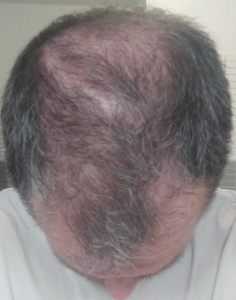Hi Docs,
I’m a white Caucasian man who turned 27 in April. I have been balding for 6 years now. I have no more doubt about that because my frontal hairline receded about 1 inch maybe more (depending on how I pull my hair back more or less) and I have got miniaturized hair on the temples. I would like to know why the dermatologist (head of a dermatology department) keeps denying my baldness and if I am really balding or not.Well, at the very beginning, I didn’t notice anything. I used to go to the hairdresser once a month. But, at the age of 24 (about 3 years ago) I could see my scalp through my hair witch obviously began thinning. And my hair’s colour wasn’t the same anymore (much clearer than before).
So, one day I decided to have my hair cut very short. That day I realized that my hairline was receding. I could see the temples that I have never had and never seen before. According to the pictures, I’m receding since the age of 21 or 22. At the age of 21 I had a full head of hair and no temples, at the age of 22, I had temples, at the age of 24 I reached the first stage of baldness and now I’m at least at the first or maybe second stage of baldness at only 27.
Well, I can assume that I’m balding and having a similar evolution as my father had (maybe a little slower) except that he started a little earlier. At the age of 18-19, my father reached the first stage of the Norwood-Hamilton scale, at the age of 27, he was at the second stage maybe a little more (almost third), at the age of 32, he was at least NWD 3, by the time he turned 37 he reached the fourth stage and now, he is a 50 years old man and he’s almost 5 (almost bald)!
In my family, my father is the only “real” bald man. My grand father (my dad’s father) is only Norwood 2 at the age of 75, my uncles (my dad’s brothers) are Norwood 1 at 47 and Norwood 2 at 52 and my mother’s father is only Norwood 1 or 1.5 at the age of 68. I have to say also that when I was a kid I had a similar implantation (very low and with no temples at all), the same hair quality (very thick) and the same hair colour (dark) as my mothers’. Now, I keep my hair long and I only cut a little of length when it’s too long and I’m hiding the temples with my hair from the middle of the head.
I have already seen the dermatologist several times and he always denied the truth by saying “You’re not balding.” or “You have got only temples.” or “You have a lot of hair” or “You have got no hair loss.” etc. The last time I have seen the dermatologist (April of 2013) he told me that I had a “very young” implantation and I had no kind of baldness and he asked me how my mother’s brothers were but she has got only sisters !
So, I would like to know if it is possible that the dermatologist is denying my baldness or maybe is not seeing it. Am I really balding or not? (My hairline receded about 1 inch or more in only 6 years. That is what I call the second stage, maybe it is still a first stage).
Thanks for reading. I wish you could answer to my question.
I don’t know what purpose it would serve for your dermatologist to deny your hair loss if you actually had genetic loss. In situations like this, I would that you get another opinion. You can send me some good quality photographs with your eyebrows lifted high so that the wrinkles of your forehead show, and then I can give you the feedback you want and apparently need. Second opinions are always a good idea if you lack the confidence in the opinions you are given.
You would need to call my office at (310) 553-9113 or (800) NEW-HAIR to set up a formal phone or in-person consultation for this. Personal / individual consultations are not given via email or this site.

 I’d say that yes, a Norwood Class 1 (see art at right) and a mature hairline are basically the same. The hairline you saw at 12 years old is your childhood hairline and it is completely normal for your hairline to mature to some degree a dozen years later. You can not tell at your age for sure, but with a good mapping of your scalp and measurements looking for
I’d say that yes, a Norwood Class 1 (see art at right) and a mature hairline are basically the same. The hairline you saw at 12 years old is your childhood hairline and it is completely normal for your hairline to mature to some degree a dozen years later. You can not tell at your age for sure, but with a good mapping of your scalp and measurements looking for 